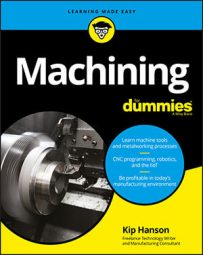Traditional cutting tools (albeit very small ones) can be produced down to around 0.001 inch in diameter (0.025 mm), and can go much smaller than this. However, when this small, the cutting tools become prohibitively expensive and are more prone to breakage. This is why EDM and especially lasers are often used to machine extremely small part features. Here again, hybrid machines able to produce parts in a single operation are quite popular in this micro-realm, since building secondary operation fixtures for parts smaller than a grain of rice is impractical.
One of the biggest obstacles to micromachining is spindle rpm. Achieving the correct surface speed for any given material is a prerequisite to achieving good cutting-tool life and part quality. This is difficult to do when tools are smaller than a sewing needle. For example, spinning a 1-inch diameter end mill at a moderate cutting speed of 300 SFM (surface feet per minute) requires only 1,200 or so rpm. But attaining that same cutting speed on a 0.010-inch end mill needs 120,000 rpm, far beyond what's available on most machine tools. Unless you have a speeder head (an air or electric-powered auxiliary spindle), it's going to be darned hard to do anything but break cutting tools.
An increasing percentage of micro parts aren't machined at all. They are made using the same etching and deposition processes used to manufacture semiconductors. These ultra-miniature, nanotechnological devices are known as MEMS (microelectromechanical systems), and without them the IoT wouldn't even exist. MEMS devices are used in gyroscopes, accelerometers, pressure sensors, and microphones in a variety of everyday products. They have tiny parts that move under stimuli and relay that information to onboard firmware and other types of integrated circuits, which in turn send the information to the cloud. MEMS sensors control heart rates in pacemakers, tell your car when to deploy its airbags, or keep your GoPro-equipped drone from an embarrassing crash into the neighbor's swimming pool.
